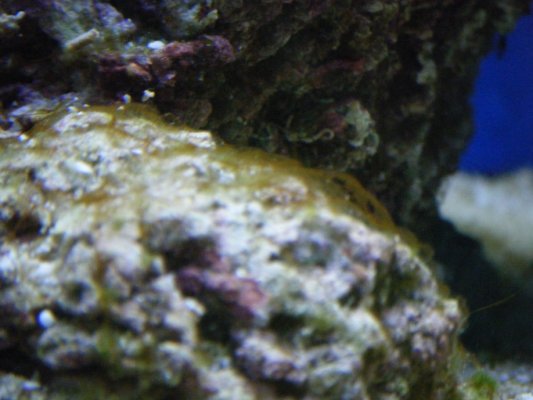Have a look at:
Problem Dinoflagellates and pH
The problem dinoflagellates encountered in reef aquaria are often brown, although they can also be almost colorless, green, yellow/green or rust colored. They form masses that coat surfaces such as the tank's walls, rock and sand. The coating often becomes filled with oxygen bubbles during the day as the organisms produce O2 during photosynthesis. The mass is often described as gelatinous, slimy, snotty or gooey. That part of the description may be the best way to distinguish it from other typical reef aquarium pests, although
other organisms in the ocean (such as chrysophytes) have a similar appearance.
Is the problem worse before lights off and a bit better before lights on?
Try cutting off al llight for 3 days.
Do you have any macro algae (cheato) in a sump/fuge? That can help outcompete the dino.
What is your Alk and pH?
High Alk (10+ and pH (8.6 - 8.8) are supposed to help kill it.
I also found this post on another forum. It is anecdotal only, but...
"I got rid of dinoflagellates in my tank in a couple of weeks. I tried several methods, and this is what I did:
I stopped all circulation pumps and within an hour an orange cloud appeared in a corner near the surface (I checked the orange substance in a microscope and identified it as dino). I siphoned out this cloud and started the circulation again.
For two days I had no lights on, but that did not seem to work. When the lights were turned back on, they just bloomed right back.
I then ordered some algen ex from fauna marine and dosed 5ml/100l for three days (not recommended), added limewater and covered the tank completely with black plastic, both sides and the top for two days. When I put the ligths back on, they soon reappeared.
After appr. one week I decided to do a water change (10%). I shut down all circulation once more, and siphoned out the orange cloud that formed. Just prior to the dinoflagellate bloom I dosed vodka, but had to stop dosing as my montiporas started to loose tissue. I have a lot of C.racemosa in my tank, and did some reading about N/P ratio of this algae. It turned out that this algae removes about 150 ppm N for every 1 ppm P.
At the same time I read a couple of articles that claimed that low nitrate could cause dino blooms, and decided to give it a try. I
raised NO3 consentration to appr 3 ppm, and within a few days dinos were completely gone.
I do not know if it was the NO3 addition (potassiumnitrate) that killed them, or other factors. They for sure survived the two first attempts, but dissapeared shortly after I started dosing KNO3. During the period it took the dinos do dissapear, I did not do anything else to kill the dinos. Lights were on for 12 hours and I did one 10% waterchange as I normally do once per week. "
(bold is my editing).
HTH


